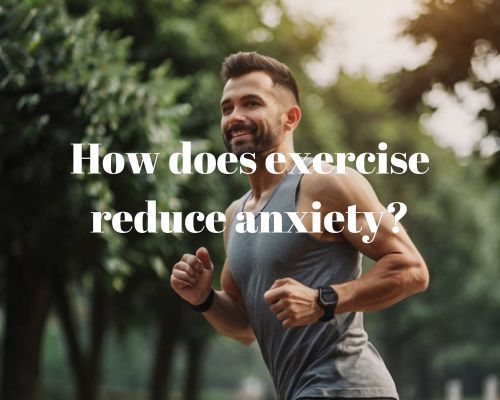How long does it take for exercise to help with anxiety: A Guide for Beginners

How long does it take for exercise to help with anxiety: A Guide for Beginners
Managing anxiety is a process that can be supported by regular exercise.
Research indicates that just five minutes of aerobic exercise may begin to produce anti-anxiety effects, offering a promising intervention for those dealing with anxiety symptoms.
While these initial effects are a great motivator, it’s worth noting that more consistent exercise routines spanning 10 to 15 weeks can significantly enhance overall mental health and reduce anxiety levels.

“Engaging in activities like resistance training, yoga, or tai chi can further contribute to the reduction of tension and anxiety.” said Jane Benson from Bikram Yoga Mornington.
These exercises not only promote physical health but also foster mental well-being.
For instance, even a short 20-minute session combining tai chi and yoga has been shown to notably decrease anxiety immediately.
The value of exercise in ameliorating anxiety lies in its ability to serve as a natural remedy that supports mental health over time.
When included as part of a holistic approach to managing anxiety, exercise can be a powerful tool, aiding in both immediate symptom alleviation and long-term resilience.
By prioritising these activities, you’re investing in your mental health while also experiencing the extensive physical benefits.
Understanding Anxiety and the Influence of Exercise
Regular exercise can significantly impact mental well-being by altering brain chemistry and reducing anxiety symptoms.
Different types of physical activities offer varying benefits, depending on factors like intensity and duration.
The time it takes to experience improvements in anxiety can differ based on exercise routine consistency and individual factors.
The Link Between Physical Activity and Mental Well-being
Engaging in physical activity is known to enhance mental health.
Exercise stimulates the release of endorphins and serotonin, which are neurotransmitters that contribute to improved mood and reduced anxiety levels.
Maintaining a consistent exercise routine can serve as a preventive measure against anxiety disorders.
By keeping the body active, you may notice a decrease in symptoms of anxiety and stress as endorphins help regulate emotional well-being.
Types of Exercise for Alleviating Anxiety
Some exercises are particularly beneficial for alleviating anxiety.
Aerobic activities such as walking, jogging, or cycling are effective in elevating heart rate, which can help reduce symptoms of anxiety.
Resistance training also offers mental health benefits, with studies indicating its effectiveness in decreasing tension and anxiety levels.
Practices like yoga and tai chi focus on mindfulness and controlled breathing, which can be beneficial for reducing stress and promoting relaxation. See Jane Benson from Bikram Yoga Mornington for more.
Timeframe for Experiencing Benefits
The timeframe in which exercise impacts anxiety can vary.
For some, anxiety reduction may occur quickly, with immediate effects noted after activities like a 20-minute yoga session.
Long-term benefits often require regular engagement in an exercise program, generally over a span of 12 weeks, to see significant changes.
The consistency of your exercise routine plays a key role in how rapidly you might experience improvements in mental health and anxiety symptoms.
Practical Strategies and Considerations for Exercise as a Tool for Anxiety Management
When using exercise to manage anxiety, it’s important to establish a sustainable routine, seek professional guidance, and integrate exercise with broader anxiety management strategies.
Each of these approaches contributes to improving self-efficacy and support for mental health.
Developing a Sustainable Exercise Routine
To manage chronic anxiety effectively, establish a regular exercise routine.
Begin with activities that match your current fitness level. A brisk walk or light strength training session can be a good start.
Consistency is key.
Commit to exercising several times a week, gradually increasing duration and intensity. This not only helps in reducing anxiety symptoms but also in building self-esteem.
It’s useful to track your progress.
Keep a simple log of your workouts and how you feel before and after each session. This monitoring can boost motivation and highlight progress.
The Role of Professional Guidance and Social Support
Enlisting the help of professionals, such as a therapist or personal trainer, can enhance the benefits of your exercise program.
These experts can help tailor an exercise routine based on your specific needs and current health topics, ensuring it’s both effective and safe.
Social support is another crucial factor.
Connecting with others through group exercises or online communities can provide encouragement and accountability, making it easier to stick to your goals.
Consider joining local exercise groups or clubs. Establish a network of friends or family members who share your aim to improve mental health through physical activity.
Beyond Exercise: Holistic Approaches to Anxiety
Exercise is a powerful tool. But combining it with other strategies can maximise its effectiveness in managing anxiety.
Integrate practices such as meditation and relaxation techniques. These will support the sympathetic nervous system in reducing stress.
Spending time in nature can complement your exercise regimen. It provides a calming backdrop and enhances overall well-being.
This holistic approach ensures more comprehensive relief from anxiety symptoms.
Additionally, paying attention to privacy practices and managing health proactively through balanced nutrition and adequate sleep further supports your mental health journey.
Combining these elements can offer you a more rounded approach to managing anxiety.

